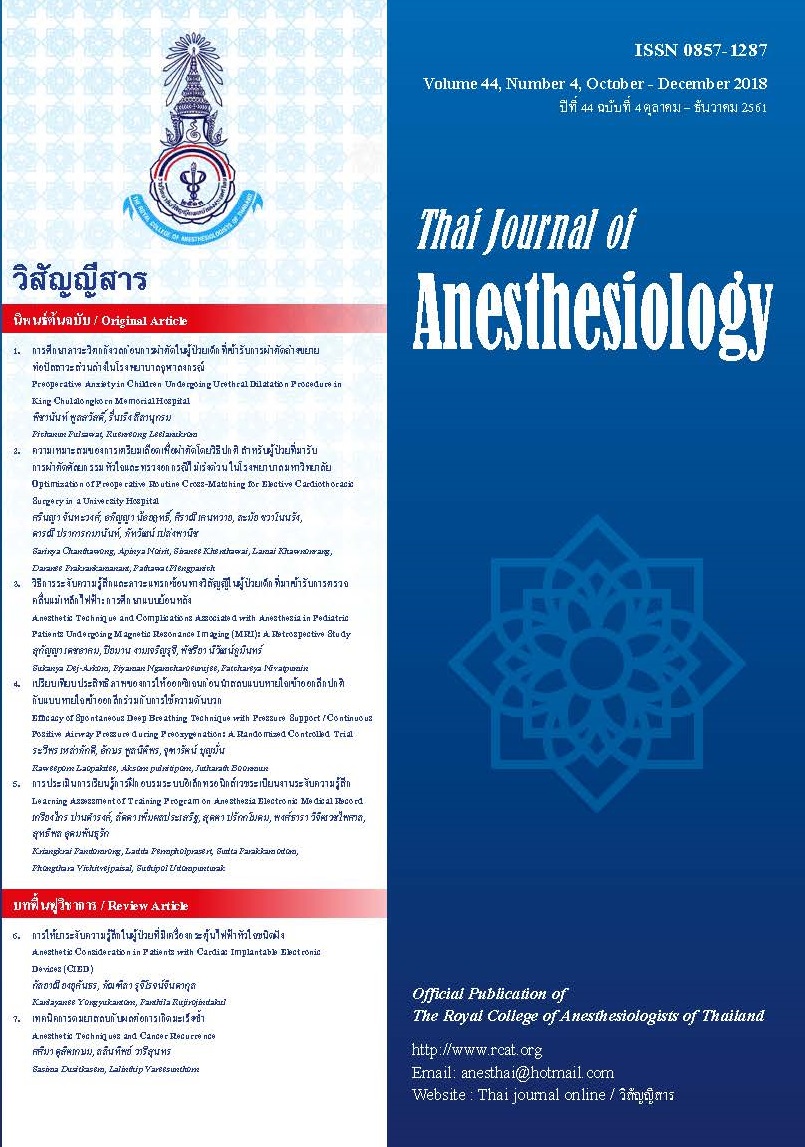Preoperative Anxiety in Children Undergoing Urethral Dilatation Procedure in King Chulalongkorn Memorial Hospital
Main Article Content
Abstract
Background: Preoperative anxiety is common problem in pediatric patients undergoing multiple anesthesia which is associated with both psychologically and physiologically adverse outcomes. Objectives of Study: To study the correlations of previous anesthetic anxiety and factors related to previous anesthesia to the present preoperative anxiety in children undergoing urethral dilation procedure. In addition, the effect of preoperative anxiety to behavioral compliance during inhalational induction of anesthesia was analyzed. Material and Method: A cross-sectional descriptive study was conducted in children aged 1-7 years presenting for elective urethral dilatation procedure in King Chulalongkorn Memorial Hospital. Previous anesthetic anxiety, previous anesthetic induction technique and the present preoperative anxiety (Modified Yale Preoperative Anxiety Scale; m-YPAS) were evaluated at preoperative holding area. Behavioral compliance was evaluated during inhalational induction of anesthesia (Induction Compliance Checklist; ICC). The correlations of previous anesthetic anxiety including factors related to previous anesthesia to present preoperative anxiety were analyzed. The association between preoperative anxiety and compliance during anesthetic induction was also assessed. Results: A hundred boys were enrolled in this study. The history of previous anesthetic anxiety and age of child were significantly related to the present preoperative anxiety (p<0.05). However, there was no association between preoperative anxiety and behavioral compliance during inhalational induction. Conclusion: Previous anesthetic anxiety, number of anesthetic experiences and age of child were associated with the present preoperative anxiety. Measures for reducing anxiety to the child at risk should be provided.
Article Details
References
2. Agnes TW, Anil V. Children’s preoperative anxiety and postoperative behavior; Review article. Ped Anesth 2003;13:188-204.
3. Kain ZN, Caldwell-Andrew AA, Maranets I, et al. Preoperative anxiety and emergence delirium and postoperative maladaptive behaviors. Anesth Analg 2004;99:1648-54.
4. Kain ZN, Mayes LC, Cicchetti DV, et al. The Yale preoperative anxiety scale: how dose it compare with a ‘gold standard’? Anesth Analg 1997;85:783-8.
5. Kain ZN, Caldwell-Andrews AA, Maranets I, Nelson W, Mayes LC. Predicting which child-parent pair will benefit from parental presence during induction of anesthesia: a decision-making approach. Anesth Analg 2006;102:81-4.
6. Ann MV, Todd GN, Joel G, Yu W, C. Dean Kurth. Factor predictive of poor behavioral compliance during inhaled induction in children. Anesth Analg 2008;197(2):413-21.
7. Mary EM, Kain ZN. The management of preoperative anxiety in children: an update. Anesth Analg 2001;93:98-105.
8. Viitanen H, Annila P, Viitanen M, et al. Premedication with midazolam delays recovery after ambulatory sevoflurane anesthesia in children. Anesth Analg 1999;89:75-9.
9. Mohammad IA, Maureen AF, Katie P, Aman K. Preoperative anxiety in children; Risk factors and non-pharmacological management. M.E.J.Anesth 2011;21(2):153-70.
10. Dreger VA, Trembeck TF. Management of perioperative anxiety in children. AORN Journal 2006;84(5):788-804.
11. Kain ZN, Mayes LC, Caramico L, et al. Distress during induction of anesthesia and postoperative behavioral outcomes. Anesth Analg 1999;88:1042-7.
12. Kain ZN, Mayes LC, Wang S, et al. Parental presence during induction of anesthesia versus sedative premedication. Which intervention is more effective? Anesthesiology 1998;89:1147-56.


